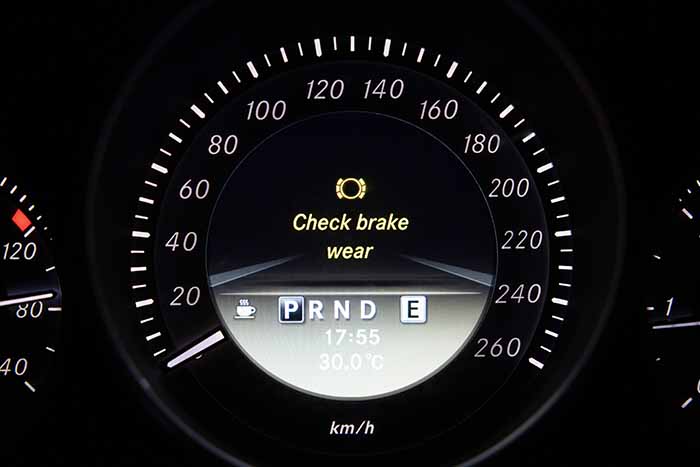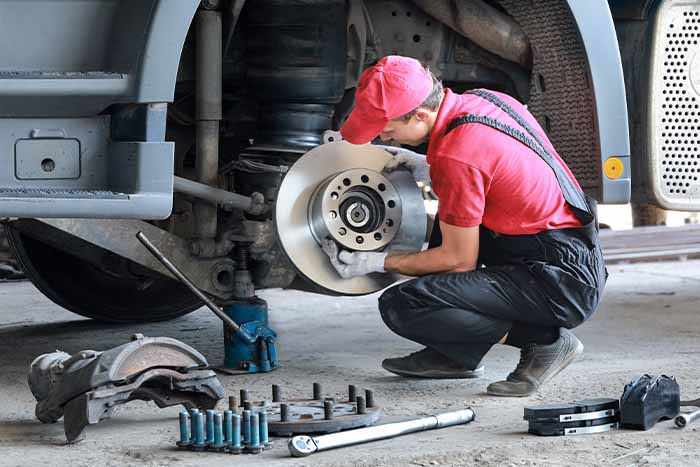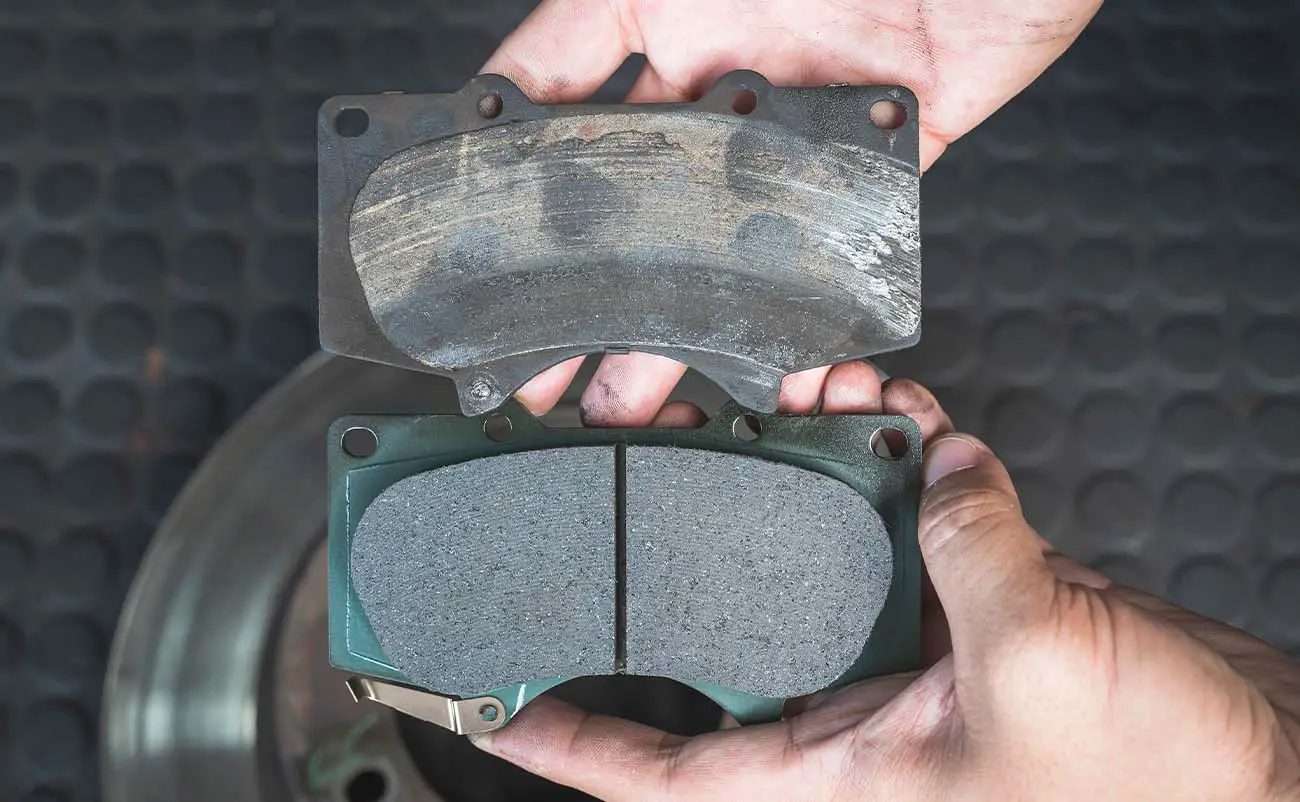Without adequately working brake pads, your car would be hazardous to drive. Since your brake pads are not easily visible, most people never really think about them unless they start causing problems. However, once your brake pads get bad enough to cause noticeable issues, you might be causing damage to other brake components like your brake rotors, brake fluid, or calipers. So, how do you know when it’s time to replace your brake pads? There are a few things that you can watch for that will signal you when it’s time for replacements. Keep reading to learn how to tell when it’s time for brake pad replacement.
Table of Contents
6 Signs You Need To Replace Your Brake Pads

Here are the things that you need to be on the lookout for. Some are extremely obvious, while others might require a little more inspection. Either way, you should perform regular checks of your braking system and have your pads replaced right away if you encounter any of these issues.
#1. Squealing Noise
When you press the brake pedal, do your brakes make a loud squealing or squeaking noise? This is likely a sign that your pads need replacing. Most pads today are made with built-in wear indicators. This is basically a thin strip of metal that is attached to the pad’s backing plate. When the pad wears, this strip of metal gets closer and closer to your rotor. Once the pad gets too thin, the metal will rub against the rotor. When the metal-on-metal rubbing occurs, you will hear a squealing noise when stopping your car. If you notice this noise, you should have a mechanic inspect your brakes right away.
#2. Brake Indicator Light
Many newer cars have indicator lights that will illuminate when it’s time to replace your pads. This is especially common on high-end vehicles like BMW or Mercedes-Benz. These vehicles have a sensor inside the pad itself. Once the pad wears below a certain level, the sensor rubs against the rotor. When it does, this friction causes the circuit inside the sensor to get broken. After the circuit breaks, the car’s computer will illuminate the warning light. When you see this light, you know it is time for new brake pads. Keep in mind that this light is usually a different one from the one that illuminates when you have brake system problems, although it might be the same on some vehicles.
#3. Grinding Noise
If you hear a grinding noise, then you have probably not been performing proper car maintenance. Once you hear your brakes grinding, you are doing additional damage and need an immediate brake service. This more than likely means that your pads have worn down to the metal backing plate, and this plate is scraping against the rotor. This will cause damage to your rotors, and it will generate excessive heat that might damage your brake fluid or even start a fire. If you hear a grinding sound when stopping your vehicle, then head to an auto repair shop immediately.
#4. Longer Stopping Distance
Maybe you have noticed that your vehicle requires a little more distance when coming to a stop. This could be the result of thin brake pads or brake shoes. Worn brake pads will increase your stopping distance in hard braking situations. Not only is this one of the warning signs of worn brake pads, but it can also be dangerous for you and others on the road. If your car does not stop as quickly as it should, then you might find yourself in an accident. When your car is taking longer to stop, then you should have your vehicle’s brake pads replaced soon.
#5. Steering Wheel Vibration
A steering wheel vibration is often another sign that your car’s brake system needs attention. Not only might your vehicle have worn pads, but your brake discs or rotors are likely warped as well. This is usually most noticeable when you gently press the brake pedal. If the steering wheel starts to vibrate when you first begin to apply the brakes, then you need to have a mechanic perform a brake inspection to determine the specific cause.
#6. Visibly Thin Pads
You should be performing regular visible inspections of your brake pads. If you aren’t sure how to check brake pads, then you should have your mechanic perform this inspection. Your brake pads should be inspected every time you perform an oil change. This will allow you to catch problems early and correct them before additional damage is done. If the friction material on your brake pads is less than a quarter of an inch thick, then you should go ahead and replace them. A thickness less than this will lead to decreased stopping ability.
How Long Do Brake Pads Last?
Brake pads usually last anywhere from 30,000 to 50,000 miles on most vehicles. You might find that some performance vehicles require new brake pads as soon as 15,000 to 20,000 miles, while some trucks might only require new pads every 75,000 miles. Your driving style also dramatically affects how quickly your pads will need replacing. The more frequently and harder you press your brake pedal, the faster your pads will wear out.
Your owner’s manual is not likely to specify an interval for brake replacement since they should be replaced as needed. Driving conditions and driving habits differ widely from person to person, so the wear rate of your brake pads will be specific to your situation. This is why it is important to keep a frequent check on your pads and watch for the warning signs that your vehicle needs a brake repair.
DIY Brake Pad Replacement Steps

Have you decided that you want to attempt to replace the brake pads on your car on your own? If so, you might be wondering how to change brake pads. Replacing pads is not an overly complicated task. The steps vary a little based on the type of brakes your vehicle has, but since most cars today have disc brakes, we will discuss those steps. Drum brakes, however, make the job a little more complicated.
First, you will need to remove the car’s wheel. Make sure that it is properly supported with a jack stand. Next, remove the brake caliper from the rotor. Be careful not to damage the brake lines during this process. If you have to add brake line replacement cost to the job, then you will negate any money that you might have saved by performing the work yourself. Remove the old brake pads and hardware from the caliper, and then gently push the piston all the way back into the caliper. Insert the new hardware and brake pads into the caliper, and reattach the caliper over the rotor.
Repeat this process for the other wheel on the same axle. Start the vehicle and gently depress the brake pedal. It will likely go all the way to the floor. Slowly allow the brake pedal to return to its normal position and then depress it again. After doing this a few times, it should feel normal. Slowly drive your car and make a couple of soft stops. If things appear to be normal, then make a couple of harder stops to properly seat the pads. Congratulations, you are all done!
The Bottom Line
There is no standard interval for replacing brake pads. It depends on your specific vehicle, pad type, and driving habits. However, there are signs that you can watch for that will signal a need for replacement. When it is time to replace your pads, you might decide to tackle the job yourself. With a few hand tools and a little know-how, you can replace your own brake pads within a couple of hours.
Frequently Asked Questions
Should you replace all 4 brake pads at once?
It is unnecessary to replace all four pads at once unless they need it. Typically, your front brake pads will wear more quickly than your rear brake pads. You should always replace both sets of pads on the same axle at one time. Do not simply replace the pads on one wheel. Go ahead and do both front sets or both rear sets at the same time. If all four need replacement, then it is perfectly fine to replace them all at once.
How much does it cost to replace brake pads?
Brake pad replacement costs are not extremely expensive, but they’re not cheap either. If you take your vehicle to the dealership, you can expect to pay anywhere from $200 to $350 per axle to have your brake pads replaced. If you do the job yourself, brake pads cost around $50 to $100 per axle. The job gets a little more expensive if you need additional parts like rotors. If your vehicle needs new rotors as well, then you can expect to add about another $300 to $400 per axle.
Can I just replace brake pads and not rotors?
Absolutely. As long as your rotors are within spec for the minimum thickness, then you do not have to replace them. Some repair shops will resurface the rotors instead of replacing them with brand new ones. This will save you some money on the repair. If you are wondering when to replace rotors, the answer is when they become too thin or too warped to repair. If the rotors are too thin, then resurfacing won’t be an option.

